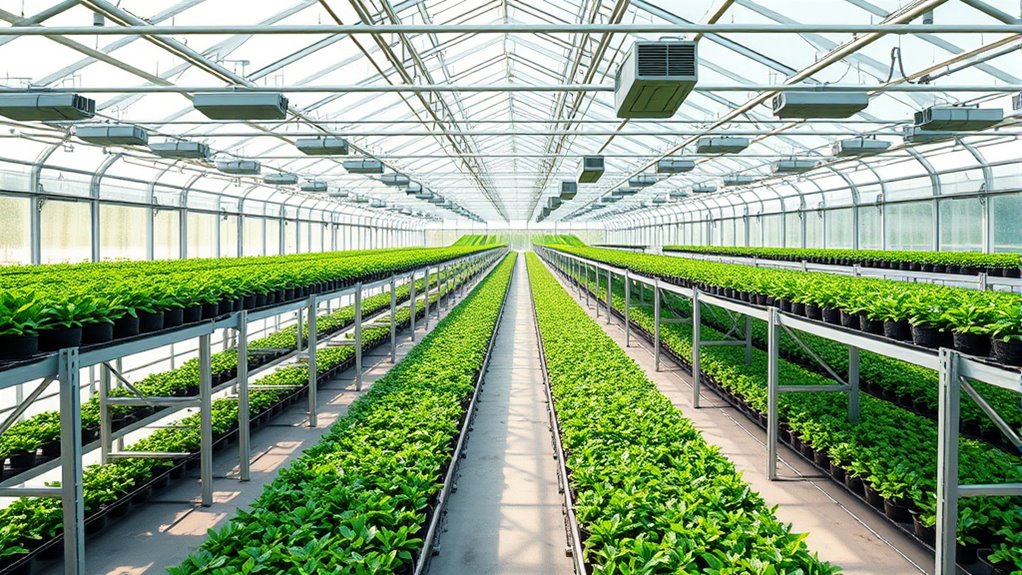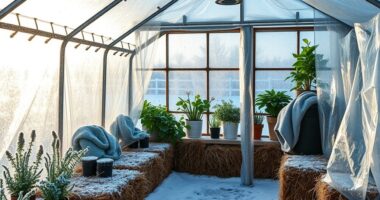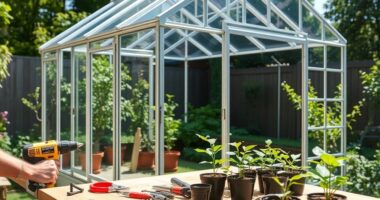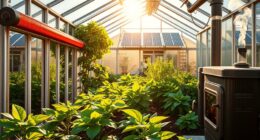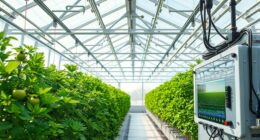To optimize your greenhouse layout for space and workflow, strategically place ventilation and irrigation systems to guarantee smooth airflow and efficient water delivery. Use natural airflow features like vents and fans, combined with automated controls, to maintain a stable environment. Position water sources near ventilation points for easy access and maintenance. Designing pathways that minimize interference and allow for future upgrades enhances productivity. Keep exploring to learn how these design tips can help you create a highly efficient, adaptable greenhouse.
Key Takeaways
- Position ventilation and irrigation systems strategically for easy access, maintenance, and efficient environmental management.
- Design clear pathways and zones to streamline workflow and minimize movement between planting, watering, and ventilation areas.
- Incorporate automated and responsive systems to maintain optimal climate and moisture levels with minimal manual intervention.
- Allocate space for future system upgrades, ensuring flexibility for expansion without disrupting current operations.
- Optimize space by arranging crop beds, equipment, and systems to maximize airflow, light exposure, and productivity.

Designing an efficient greenhouse layout is essential for maximizing plant growth and operational productivity. When planning your space, one of your top priorities should be establishing effective ventilation strategies. Proper ventilation regulates temperature, humidity, and air circulation, which are crucial for healthy plant development. You want to create a system that facilitates continuous airflow, reducing the risk of mold, pests, and disease. Incorporate exhaust fans, side vents, and roof vents to promote natural airflow, and consider integrating automated systems that respond to temperature and humidity levels. A well-designed ventilation setup keeps the environment stable, prevents overheating during hot days, and maintains consistent conditions for your crops, ultimately boosting growth rates.
Effective greenhouse ventilation ensures optimal climate control for healthier, faster-growing plants.
Alongside ventilation, your irrigation systems play a vital role in layout efficiency. An optimized irrigation setup ensures your plants receive the right amount of water without wasting resources or creating overly moist conditions that invite problems. Drip irrigation, for example, allows precise delivery directly to plant roots, minimizing water use and reducing runoff. This system can be easily integrated into your layout, running along rows or beds, and controlled via timers or moisture sensors. Alternatively, overhead sprinklers provide broader coverage for certain crops but require careful placement to avoid overwatering or uneven distribution. Whichever system you choose, plan for easy access to controls and maintenance points to keep your irrigation functioning smoothly. Positioning water sources and filters strategically within your layout minimizes the length of supply lines and reduces potential disruptions.
In designing your greenhouse, you must also consider how ventilation and irrigation systems intersect with your overall workflow. For example, placing water reservoirs and control units near ventilation points can streamline maintenance and reduce downtime. This integrated approach helps you monitor environmental conditions more effectively and respond quickly to any issues. Additionally, designing pathways that allow unobstructed movement between ventilation equipment and irrigation zones enhances operational efficiency. You’ll want to ensure easy access for adjustments, repairs, and routine checks, which saves time and prevents delays during critical periods.
Finally, keep in mind that flexibility is key. Your initial layout should accommodate future upgrades to ventilation or irrigation systems as your needs evolve. Strategic placement of systems can simplify future modifications and expansions, ensuring your greenhouse remains adaptable. By thoughtfully planning the placement of these systems, you create a sustainable, productive environment that encourages healthy plant growth while making daily operations smoother. Combining strategic ventilation strategies with efficient irrigation systems not only improves plant health but also maximizes your greenhouse’s overall productivity, helping you achieve your agricultural goals more effectively.
Frequently Asked Questions
How Does Climate Control Impact Layout Efficiency?
Climate control considerably impacts your layout efficiency by ensuring ideal conditions across climate zones. Proper ventilation strategies help regulate temperature, humidity, and airflow, reducing hot spots and stagnant air. When you design your greenhouse with these factors in mind, you improve plant health and energy use. Efficient climate control minimizes adjustments needed, streamlines workflow, and maximizes space utilization, making your greenhouse operation more productive and sustainable.
What Are Cost-Effective Layout Options for Small Greenhouses?
You should consider cost-effective layout options like using cost-saving materials and modular structures. These choices help you maximize space, reduce expenses, and allow flexibility for future expansion. Incorporate narrow pathways to save space, stackable shelving to optimize vertical growth, and portable benches for easy reconfiguration. By focusing on affordability, adaptability, and efficient use of resources, you’ll create a functional, budget-friendly greenhouse that meets your gardening needs without breaking the bank.
How Can Automation Be Integrated Into Greenhouse Design?
You can integrate automation into your greenhouse by installing robotic harvesting systems to save time and labor. Automated watering systems guarantee consistent moisture levels, reducing waste and enhancing plant health. Position these systems strategically within your layout to maximize efficiency and workflow. Incorporate sensors and controllers for real-time adjustments, making your greenhouse smarter and more productive without sacrificing space, ultimately optimizing your overall design and operations.
What Safety Considerations Influence Greenhouse Layout Planning?
Imagine a greenhouse where hazards lurk unseen, ready to strike. You must prioritize hazard identification, ensuring pathways remain clear for swift emergency access. Design your layout to minimize trip risks and safeguard ventilation systems, preventing accidents. Keep exits unobstructed and install safety equipment strategically. By doing so, you create a safe environment where emergencies are swiftly managed, and your crops—and people—are protected from harm.
How Does Crop Type Affect Greenhouse Spatial Arrangement?
You should consider crop type when arranging your greenhouse, focusing on crop zoning and plant density. For instance, high-density crops like leafy greens need more space-efficient layouts, while larger plants require more room to grow. Tailor your spatial arrangement to optimize airflow, lighting, and accessibility, ensuring each crop’s specific needs are met. This approach improves productivity and simplifies maintenance, making your greenhouse more efficient and responsive to different plant requirements.
Conclusion
As you finalize your greenhouse layout, remember that a well-designed space is like a carefully choreographed dance, where every step flows seamlessly. Think of it as planting a garden of harmony, where efficiency and growth flourish side by side. With thoughtful planning, your greenhouse becomes a thriving sanctuary—much like a symphony reaching perfect harmony—where every element works together to nurture your plants and your passion for gardening.
